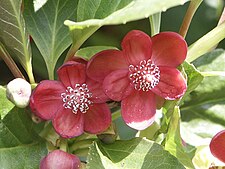| Magnolia vine | |
|---|---|

| |
| Schisandra chinensis | |
| Scientific classification | |
| Kingdom: | Plantae |
| Clade: | Tracheophytes |
| Clade: | Angiosperms |
| Order: | Austrobaileyales |
| Family: | Schisandraceae |
| Genus: | Schisandra Michx.[1] |
| Synonyms[2] | |
| |

Schisandra, the magnolia vines, is a genus of twining shrubs that generally climb on other vegetation. Various authors have included the plants in the Illiciaceae[3]
Schisandra (also spelled Schizandra) is native to Asia and North America, with a center of diversity in China.[2][4][5]
Some species are commonly grown in gardens as ornamentals. It is a hardy deciduous climber which thrives in almost any kind of soil; its preferred position is on a sheltered, shady wall. It may be propagated by cuttings of half-matured shoots in August.
Despite its common name "magnolia vine", Schisandra is not closely related to the true magnolias.
Its dried fruit is sometimes used medicinally. In China, the berries of S. chinensis are given the name wǔwèizǐ (五味子; 'five flavor fruit') because they possess all five basic flavors in Chinese herbal medicine: salty, sweet, sour, pungent (spicy), and bitter. In traditional Chinese medicine it is used as a remedy for many ailments: to resist infections, increase skin health, combat insomnia, coughing, and thirst.[6]
The extract of S. rubriflora, a native of the Yunnan province, was found to contain complex and highly oxygenated nortriterpenoids called rubriflorins A-C.[8]